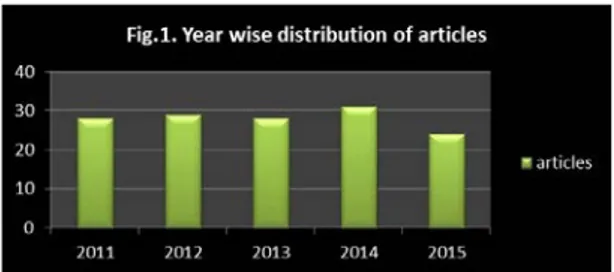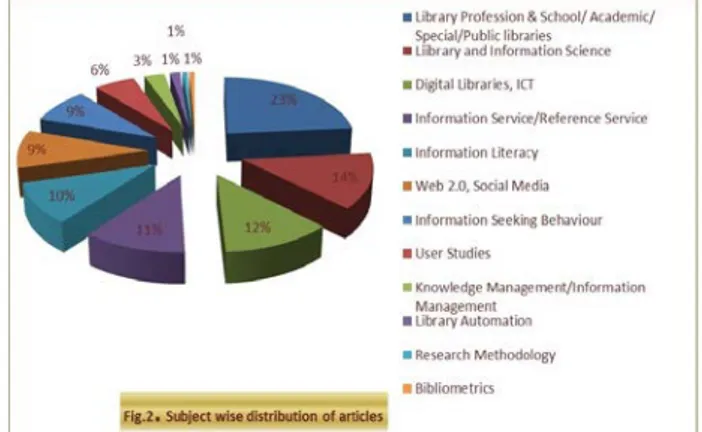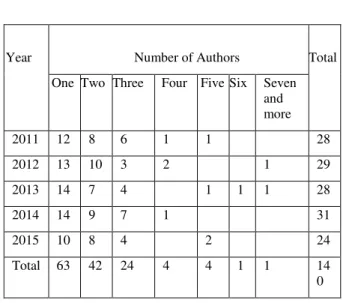BIBLIOMETRIC ANALYSIS WITH SPECIAL
REFERENCE TO AUTHORSHIP PATTERNS
AND COLLABORATIVE RESEARCH IN THE
LIBRI: INTERNATIONAL JOURNAL OF
LIBRARIES AND INFORMATION SERVICES
Khan Daud (1)
(1) Research Scholar, Department of Library and Information Science, Amu, Aligarh, Up, India, daudk297@gmail.com
Abstract
The ultimate purpose of the present study is to explore the bibliometric analysis of the LIBRI: International Journal of Libraries and Information Services journal during the period of 2011-2015. The analysis covers sundry features of the journal such as its yearly output of articles, subject distribu-tions, geographical distributions of authors, authorship pat-terns, relative growth rate and double time of publication. The result concludes that 140 research articles were pubished
in the LIBRI journal during the stipulated span i.e. 2011-2015, in which 63 (45%) articles were written by a single author whereas 77 (55%) articles were multi-authored. In the study, the average degree of author collaboration was 0.55 and it ranged from 0.57 to 0.58.
Keywords: LIBRI; Bibliometric Analysis; Authorship Pattern; Author Productivity; Degree of Collaboration
1 Introduction
This is an age of research and expedition in every field of knowledge. The consequent increase in the produc-tion of informaproduc-tion is best reflected in the literature of every discipline. Due to the expeditious growth and burgeoning development, libraries engender various studies, which must be efficacious in nature. These studies resulted in discernment and application of suit-able quantitative measuring techniques known as Bib-liometrics. Bibliometric studies project the pattern of literature growth, its use, correlate diverse branches of knowledge, build up template of collection, productivi-ty and influence authors, etc.
2 Libri: International Journal of Libraries and
Information Services
LIBRI is a peer-reviewed international journal, was launched in 1950 with the aim to facilitate information exchange among library and information science pro-fessionals worldwide. It is a scholarly journal pub-lished quarterly in English language. It publishes case studies, theoretical explanation, latest development in the discipline etc.
3 Literature Review
the resources and created knowledge in a better way. Likewise, Arya and Sharma (2011) examined the coor-dinated efforts in research and authorship trend within the vicinity of veterinary sciences all around the globe with unique locus to India from ‘CABI abstracts” dur-ing the span i.e. 2006-2010. The results of the study unconcealed that collaborative research has been fa-vored by the researchers over that of lone research. Moreover, average degree of collaboration was found 0.84 that additionally designates predominance of col-laborative research over solo research. In parallel, Mani (2014) directed a bibliometric investigation of Malay-sian Journal of Library and Information Science to ex-amine the authorship pattern, contributor profitability, articles written by single and multiple authors, most prolific researcher and level of collaborative efforts. Normal number of authors per paper is 2.06. The most astounding number of creator profitability i.e., 72 (12.52%). During the span of study, maximum 180 (64.51%) number of the articles contributed by multi-author with 0.64 degree of collaboration. Hussain and Fatima (2011) in their studies, discussed the various issues like authorship pattern, distribution of articles subject wise and year wise, forms of documents cited etc.. They reported substantial growth towards collabo-rative research and quality of articles appeared in the journal were considerably excellent.
Authorship is an overt phenomenon reflecting the modern practices by pellucidly exhibiting patterns of communication, proficiency and coordinated effort and impacts among scholars albeit the fact that their capaci-ties and potentials aren’t nicely understood. Thus, the erudition of this relationship is expedient in the study of their vigor in communication among scholars. It additionally avails in assessing scientific productivity and in determining research patterns of a subject or specialty (Ding, Schubert and Chowdhury, 1998). The authorship collaboration research is a well- apperceived attribute of the cutting edge science and there has been a steadfast trend towards inflated collaborative research in all branches of knowledge amid the existing century. It is conjointly been found that the rapidity of increased in multiple authorship pattern dappled considerably within the vicinity of each and every fragment of knowledge (Amsaveni, Manikandan and Manjula, 2013).
4 Objectives of the Study
The objectives of the present study are as follows: to make an analysis of articles published in LIBRI during the period 2011-2015; to examine the contributions by year and issue; to investigate authorship patterns by year and issue; to find out the relative growth rate and double time of publication; to study author productivi-ty; to identify the degree of author collaboration.
5 Methodology
The proposed study is conducted on the 5 volumes, 20 issues of the LIBRI journal published during the stipulated span of study i.e. 2011-2015. The data were gathered from the LIBRI journal website (http://www.degruyter.com/view/j/libr) through which 140 research articles composed from volume 61 in 2011 to volume 65 in 2015.
Research contributions by issue and year, authorship patterns, degrees of author collaboration and author’s productivity were recorded. These data were organized, calculated, tabulated, and analyzed by using simple arithmetic and statistical methods for its results.
6 Results and Discussions
6.1 Growth of Literature (Year & Subject Wise Distribution of Publication)
Year Volume No. of Issues
No. of articles
Percentage
2011 65 4 28 20.00%
2012 64 4 29 20.72%
2013 63 4 28 20.00%
2014 62 4 31 22.14%
2015 61 4 24 17.14%
Total 140 100%
Table I. Year wise distribution of articles
Figure 1: Year wise distribution of articles
In order to find out the number of research articles dur-ing the span of study under the purview of LIBRI jour-nal, a year wise analysis was made.
i.e. 2011-2015 in the journal LIBRI. On an average per year, the LIBRI journal has published 28 research arti-cles. Table I clearly divulges that highest number of articles - 31 (22.14%) were published in the year 2014, whereas the lowest number of 24 articles (17.14%) were published in the year 2015.
Subject No. of
Articles
Rank Percentage
Library Profession & School/ Academic/ Special/Public libraries
33 1 23.57%
Library & Infor-mation Science
19 2 13.57%
Digital Libraries, Information and Communication Technology
17 3 12.14%
Information Service/ Reference Service
16 4 11.43%
Information Literacy 14 5 10.00%
Web2.0, Social Media 13 6 9.29%
Information Seeking Behavior
12 7 8.58%
User Studies 8 8 5.71%
Knowledge Manage-ment/ Information Management
4 9 2.86%
Library Automation/ Library Automation Software
2 10 1.43%
Research Methodology
1 11 0.71%
Bibliometrics/ Scientometrics/ Webometrics
1 11 0.71%
Total 140 100%
Table II. Subject wise distribution of Articles
Figure 2: Subject wise distribution of article
With a view to identify the major subject areas in which research articles have come in LIBRI journal, a detailed analysis was made. The titles of the research articles were examined in order to ascertain their spe-cific subject. For the analysis, major subject division from DDC (23rd edition) was used and the subject headings given by Sears list of Subject Heading (21st edition) were also helpful to determine the specific subjects.
Table II reveals the contribution of research articles published on various subjects in the LIBRI journal. The analysis shows that the majority of the research articles appeared under Library Profession & School/ Academ-ic/Special/Public libraries with 33 (23.57 %) followed by Library & Information Science 19 (13.57%), Digital Libraries, Information and Communication Technology 17 (12.14%), Information Service/ Reference Service 16 (11.43%), Information Literacy 14 (10%), Web2.0, Social Media 13 (9.29%), Information Seeking Behav-ior 12 (8.58%), User Studies 8 (5.71%), Knowledge Management/ Information Management 4 (2.86 %), Library Automation/ Library Automation Software 2 (1.43%), Research Methodology 1 (0.71%) and Bibli-ometrics/Scientometrics/ Webometrics 1 (0.71%). 6.2 Geographical Distribution of Articles
Country No. of Articles Percentage
South Africa 23 16.43%
USA 18 12.86%
Nigeria 12 8.57%
Taiwan 8 5.72%
Malaysia 7 5.00%
United Kingdom 7 5.00%
China 6 4.29%
Korea 5 3.58%
Canada 4 2.87%
Germany 4 2.87%
Iran 4 2.87%
Croatia 3 2.15%
Pakistan 3 2.15%
Israel 2 1.42%
Finland 2 1.42%
Turkey 2 1.42%
Spain 2 1.42%
Australia 2 1.42%
Iceland 2 1.42%
Singapore 2 1.42%
Latvia 1 0.71%
Texas 1 0.71%
Japan 1 0.71%
India 1 0.71%
Portugal 1 0.71%
West Indies 1 0.71%
Denmark 1 0.71%
Sweden 1 0.71%
Cuba 1 0.71%
Jordan 1 0.71%
New Zealand 1 0.71%
Massachusetts 1 0.71%
Brazil 1 0.71%
Scotland 1 0.71%
Botswana 1 0.71%
Poland 1 0.71%
Slovenia 1 0.71%
Total 140 100%
Table III. Geographical Affiliation of Authors
The data regarding research articles were analyzed ac-cording to their country of origin. Table III gives the geographical distribution of research articles in the LIBRI journal. This table contains a list of 38 coun-tries, wherein the number of research articles published from these 38 countries is 140.
South Africa ranks first with 23 articles forming 16.43% of the total 140 articles. It is followed by USA contributing with 18 articles (12.86%), Nigeria ranks next to USA with 12 articles (8.57%). This is followed by Taiwan, Malaysia, UK, and China sharing the fourth, fifth, fifth, sixth places respectively, with their article contribution 8 (5.72%), 7 (5%), 7 (5%), 6 (4.29%) respectively.
From the above table, we can infer that seven countries (South Africa, USA, Nigeria, Taiwan, Malaysia, UK, China) which share the first six ranks contribute ap-proximately with 61.43% research articles published during the stipulated period. The rest of the research articles (38.57%) are from 37 countries. It can be con-cluded that South Africa contributed with a maximum number of research articles to the LIBRI journal fol-lowed by USA, Nigeria, Taiwan, Malaysia, UK, China 6.3 Relative Growth Rate and Double Time of
Publication
The Relative Growth Rate [R(P)] and Doubling Time [Dt(P)] of Publication are given below in Table IV. From the analysis, it was found that there is a sudden decrease in the relative growth rate of Publication [R(P)] with the rate of 0.71 in 2012 to 0.19 in 2015. The mean relative growth of the five years (i.e. 2011 to 2015) showed a growth rate of 0.40. The analogous doubling time [Dt (P)] progressively increases from 0.98 in 2012 to 3.64 in 2015.The mean Doubling Time of the five years (i.e. 2011 to 2015) was 2.14. There-fore, the speed of growth of publication was reduced, whereas the corresponding Doubling Time was exag-gerated. (Appendix)
6.4 Authorship Pattern
Year Number of Authors Total
One Two Three Four Five Six Seven and more
2011 12 8 6 1 1 28
2012 13 10 3 2 1 29
2013 14 7 4 1 1 1 28
2014 14 9 7 1 31
2015 10 8 4 2 24
Total 63 42 24 4 4 1 1 14
0
With a view to identify the extent of research conduct-ed by individuals in collaboration with each other, the number of authors mentioned in the research articles was counted and analyzed. Table V displayed the au-thorship pattern of research articles that contributed to LIBRI journal for the duration of 2011 to 2015. It is clear from the analysis that multiple authorship has the foremost publications, i.e. 77 (55%) articles, whereas the single authored has 63 (45%) articles. The multi authorship patterns were cautiously studied to reveal more insight on the collaborative effort. Maxi-mum number of articles were with two authors 42 (30%), articles with three authors 24 (17.14%), articles with four authors 4 (2.86%), articles with five authors 4 (2.86%) and articles with more than five authors were 3 (2.14%).
It is emerging that Collaborative research is very much a feature of the library and information Science educa-tion. This demonstrates a pattern that more researchers and library experts are meeting up to accomplish the research activities and studies in library and Infor-mation science field.
6.5 Author Productivity
The scientific profitability of researcher is measured by the quantity of productions delivered by them in a spe-cific timeframe. With respect to creator efficiency, a year insightful itemized examination was made.
*Average Authors per Paper (AAPP) = Number of authors/ Number of papers.
Productivity per author= Number of papers/ Number of authors.
Year Total no. of Arti-cles
No. of Authors
AAPP* Productivity Per Year
2011 28 55 1.96 0.51
2012 29 66 2.28 0.44
2013 28 70 2.50 0.40
2014 31 57 1.84 0.54
2015 24 48 2.00 0.50
Total 140 296 2.11 0.48
Table VI. Author Productivity
Table VI exhibited the information identified to author productivity, which demonstrates that the total average number of authors per paper is 2.11 and the average productivity per author is 0.48. The most astounding number of author productivity, i.e., 70 (2.50) was dis-tributed in the year 2013
6.6 Degree of Collaboration in Research
The level of coordinated effort in research was discov-ered utilizing the equation stipulated by Subramanyam (1983). The equation is
C = Nm / Nm + Ns
Where C= degree of collaboration in a discipline Nm = Number of multi-authored research articles in the discipline
Ns = Number of single authored research articles in the discipline
C = Nm/ Nm + Ns C = 77/ 140 C = 0.55
Thus the degree of collaboration (C) during the overall 5 years (2011-2005) is 0.55. But when we calculate the year wise degree of collaboration for 5 years the results arise different as given in table VII.
Year Single Authored Paper (Ns)
Multi Authered Paper (Nm)
Total
(Nm+Ns)
Degree of Collaboration
2011 12 16 28 0.57
2012 13 16 29 0.55
2013 14 14 28 0.50
2014 14 17 31 0.55
2015 10 14 24 0.58
Total 63 77 140 0.55
Table VII. Volume wise Degree of Collaboration
Table VII demonstrated the year wise degree of author collaboration. It is clearly depicted from the table VII, that the degree of collaboration ranges from 0.57 to 0.58 and the average degree of collaboration is 0.55. However, multi-authored articles have been increased in recent years. In 2012, there were 12 single authored contributions and 16 multi-author papers, and in 2015, there were 10 single authored articles and 14 multi-author contributions. It can be concluded that multi authorship is dominated over single authored contribu-tions.
7 Findings & Conclusion
papers and the background of contributors are all evi-dences of this. During the course of years the LIBRI journal had expanded its scope. But within the period of study, not much variation in its contents is seen. During the stipulated span of study 2011-2015, the LIBRI journal published 140 research articles and max-imum number of articles appeared in the area of “Li-brary Profession & School/ Academic/Special/Public libraries” with 33 (23.57%). Furthermore, the present study reveals that the highest number of research arti-cles were from South Africa with 23 (16.43%). The authorship patterns have changed from the overwhelm-ing retired soverwhelm-ingle authors to expand multi-author joint efforts as of late. In the present study, multiple author-ship has the most prolific publications, i.e. 77 (55%) articles while the single authorship pattern has 63 (45%) articles. Indeed, even among the collaborating authors, the nature of collaboration is generally be-stowed to two authors. The Relative Growth Rate of Publication [R(P)] decreases with the momentum of 0.71 in 2012 to 0.19 in 2015.The mean relative growth of the five years (i.e. 2011 to 2015) showed a growth rate of 0.40. The corresponding Doubling Time for different years [Dt (P)] gradually increased from 0.98 in 2012 to 3.64 in 2015.The mean Doubling Time of the five years (i.e. 2011 to 2015) was 2.14. The degree of collaboration ranges from 0.57 to 0.58 and the aver-age degree of collaboration is 0.55.
References
Amsaveni, N.; Manikandan, M.; Manjula, M. (2013). Authorship pattern and collaborative research in bioinformatics.// Interna-tional journals of computer science and mobile computing 2:11 (2013) 230-238.
Arya, C.; Sharma, S. (2011). Authorship trends and collaborative research in veterinary sciences: A bibliometric study.// Chinese Librarianship: an International Electronic Journal 34 (2011) 1-9. Ding, Ying; Schubert Foo; Gobinda, Chowdhury (1998). A biblio-metric analysis of collaboration in the field of information
re-trieval.// The International Information & Library Review 30:4 (1998) 367-376.
Hussain, Akhtar; Nishat Fatima (2011). A bibliometric analysis of the ‘Chinese Librarianship: an International Electronic Journal, (2006-2010)’. // Chinese Librarianship: an International electron-ic journal .
Khaparde, Vaishali, and S. Pawar (2013). Authorship pattern and degree of collaboration in Information Technology. // Journal of Computer Science & Information Technology 1:1, (2013) 46-54. LIBRI. 2016. LIBRi Issues. Accessed January 10, 2016.
http://www.degruyter.com/view/j/libr.2015.65.issue-4/issue-files/libr.2015.65.issue-4.xml
Mani, Kotti Thavamani, 2014. Authorship Patterns and Collaborative Research in Malaysian Journal of Library and Information Sci-ence, 1996 - 2012". // Library Philosophy and Practice
(e-journal). Paper 1177.
http://digitalcommons.unl.edu/libphilprac/1177
Subramanyam, Krishnappa (1983). Bibliometric studies of research collaboration: A review. // Journal of information Science 6, no. 1 (1983) 33-38.
Thanuskodi, S (2011). Library Herald Journal: a bibliometric study. Researchers World 2: 4, (2011) 68.
Velmuurugan, C.; Radhakrishnan, N. (2015). Webology journal: a scientometric profile.// International Journal of Information Dis-semination and Technology 5:2 (2015) 137.
Copyright: © 2016 Daud. This is an open-access article distributed under the terms of the Creative Commons CC Attribution-ShareAlike (CC BY-SA), which per-mits use, distribution, and reproduction in any medium, under the identical terms, and provided the original author and source are credited.
Received: 2016-06-20. Accepted: 2016-06-27
Appendix
Year No. of
Articles
Cumulative no. of Articles
Loge1p Loge2p [R(P)] Mean
[R(P)]
[Dt(P)] Mean
[Dt (P)]
2011 28 28 - 3.33 -
0.40 2.14
2012 29 57 3.33 4.04 0.71 0.98
2013 28 85 4.04 4.44 0.40 1.73
2014 31 116 4.44 4.75 0.31 2.23
2015 24 140 4.75 4.94 0.19 3.64




